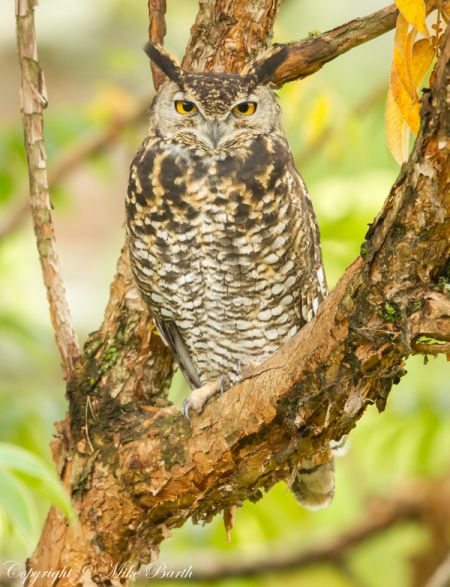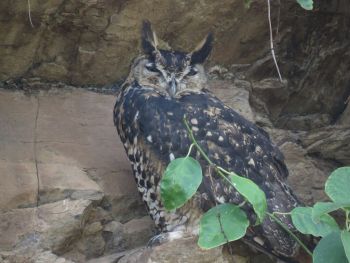- Bubo capensis
Includes Mackinder's Eagle-Owl
Identification
Length 48-58 cm (19-22¾ in)
- Dark brown, buff spotted upperparts
- Creamy-buff, dark blotched underparts
- Pale buff facial disk
- Orange-yellow iris
Distribution
Africa
Eastern Africa: Eritrea, Ethiopia, Kenya, Uganda, Tanzania, Mozambique andMalawi
Southern Africa: Zimbabwe, Namibia, South Africa, Lesotho and eSwatini
Taxonomy
Subspecies
Bubo capensis has three subspecies:[1]
- B. c. dillonii
- B. c. mackinderi
- Kenya and Uganda to Zimbabwe, Mozambique and Malawi
- B. c. capensis
- Extreme southern Namibia and South Africa
mackinderi is sometimes considered a full species Mackinder's Eagle Owl[2].
Habitat
Mountainous regions, hilly country, and rocky gorges.
Behaviour
Diet
The diet includes mammals, birds, reptiles, frogs and large invertebrates.
Breeding
A scrape is made in a cliff ledge, in cave entrance or under bush. The 1-3 eggs are incubated for 35 days. The young fledge 6-7 weeks later.
References
- Clements, J. F., T. S. Schulenberg, M. J. Iliff, S. M. Billerman, T. A. Fredericks, B. L. Sullivan, and C. L. Wood. 2019. The eBird/Clements Checklist of Birds of the World: v2019. Downloaded from http://www.birds.cornell.edu/clementschecklist/download/
- Lepage D. (2020) [Avibase - https://avibase.ca/C4227465]. Retrieved 29 November 2020
- World Owl Trust
Recommended Citation
- BirdForum Opus contributors. (2024) Cape Eagle-Owl. In: BirdForum, the forum for wild birds and birding. Retrieved 16 April 2024 from https://www.birdforum.net/opus/Cape_Eagle-Owl
External Links
GSearch checked for 2020 platform.





